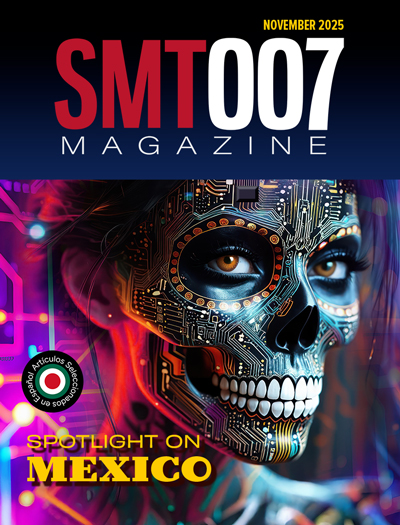-

-
News
News Highlights
- Books
Featured Books
- smt007 Magazine
Latest Issues
Current Issue
Spotlight on Mexico
Mexico isn’t just part of the electronics manufacturing conversation—it’s leading it. From growing investments to cross-border collaborations, Mexico is fast becoming the center of electronics in North America. This issue includes bilingual content, with all feature articles available in both English and Spanish.

Production Software Integration
EMS companies need advanced software systems to thrive and compete. But these systems require significant effort to integrate and deploy. What is the reality, and how can we make it easier for everyone?

Spotlight on India
We invite you on a virtual tour of India’s thriving ecosystem, guided by the Global Electronics Association’s India office staff, who share their insights into the region’s growth and opportunities.
- Articles
- Columns
- Links
- Media kit
||| MENU - smt007 Magazine
2D X-ray Inspection With Materials and Thickness Identification
June 7, 2017 | Paul D. Scott, Ph.D., IBEX Innovations, and Evstatin Krastev, Ph.D., P.E., Nordson DageEstimated reading time: 7 minutes
Figure 2: Materials curves (left) generated from training the system on the wedge samples (right).
MACHINE LEARNING/USER INTERFACE
Machine learning algorithms have been developed to enable decisions to be made on material type and thickness based on the materials space plots generated from the image obtained using the MAP. The algorithms require training using a set of training standards. Once the training stage is complete, the algorithm is able to identify the material and thickness of previously unseen samples. Under ideal test conditions, the algorithm has been shown to have a misclassification rate of less than 2% and is able to identify thickness to better than 1% of the true value.
Once the MAP has been fitted to the CMOS detector, the calibration, database training and sample analysis are handled by a simple user interface which is integrated into the X-ray inspection system software. An example is shown in Figure 3, where wedges of three materials are trained and used to identify the material types on the right of the image.
Figure 3: Screen shots showing a user interface which is designed to allow materials training (top) and identification (bottom).
The algorithm works at a rate compatible with image acquisition times and generates a standard grey-scale image as part of the process.
EXAMPLE APPLICATIONS
This article is focused on discussing the X-ray MAP inspection technology for the electronics industry, including PCBs and semiconductor applications. In this section, we show some examples of the MAP X-ray inspection technology applied in the security and food industries. The intention is to enhance the reader’s understanding of the technology and to facilitate the generation of ideas and requirements that can apply for the electronics industry.
Security Inspection
Security threats may be disguised within everyday objects such as laptops and mobile telephones, which are legitimately carried. X-ray security scanners typically use measurements taken at two voltage settings of the X-ray generator in order to generate materials information. This approach requires two scans. Using the MAP, the measurement can be reduced to a single scan at only one voltage setting.
A desk telephone, shown in Figure 4, was measured as an example of a complex object containing electronic circuitry and plastics. Data were collected at 120 kV, 0.5 mA, with a 0.5 s exposure, using a conventional, low-power tungsten X-ray source and a silicon flat-panel detector equipped with the MAP technology. Analysis of the image data leads to the materials discrimination image shown in Figure 4 (right). The color-scheme here is one typically used in security applications: plastics and other organic materials are presented in orange; so called poor metals, such as aluminum, are shown in green; denser metals are shown in blue.
Figure 4: (Left) Absorption contrast image of a telephone. (Right) Materials contrast image showing plastics (orange), poor metals (green) and dense metals (blue).
We see the potential for the same techniques to be applied in PCB inspection to highlight inconsistencies in circuit boards and other electronic components.
To read the full version of this article, which appeared in the June 2017 issue of SMT Magazine, click here.
Page 2 of 2Testimonial
"Advertising in PCB007 Magazine has been a great way to showcase our bare board testers to the right audience. The I-Connect007 team makes the process smooth and professional. We’re proud to be featured in such a trusted publication."
Klaus Koziol - atgSuggested Items
Mycronic Unveils BA 01 Small Dot Ejector for Next-Generation Precision Jet Printing
11/12/2025 | MycronicMycronic’s BA 01 small dot ejector, delivers unmatched precision in solder paste jet printing for advanced PCB designs.
Indium is Electrifying the Future with Advanced Materials Solutions at productronica
11/11/2025 | Indium CorporationAs one of the leading providers in advanced materials solutions for power device packaging and materials for the electronics assembly and solder industries, Indium Corporation® is proud to feature its lineup of high-reliability products at Productronica, taking place November 18-21, in Munich, Germany.
KOKI to Host Technical Webinar on Dewetting Defects in SMT Soldering
11/11/2025 | KOKIKOKI, a global leader in advanced soldering materials and process solutions, announced its upcoming technical webinar, “Understanding and Preventing Dewetting Defects in SMT Soldering.”
Discover the Benefits of Inkjet with Electra Polymer at Productronica 2025
11/10/2025 | Electra Polymers LtdElectra Polymers will be showcasing ElectraJet® EMJ110, our advanced low-loss inkjet soldermask, ideal for high-speed and high-frequency PCB applications, at productronica 2025.
Redefining Solder Paste Application – Essemtec Reaches 1.1 Million Dots per Hour
11/06/2025 | EssemtecEssemtec, the Swiss manufacturer of adaptive SMT and dispensing solutions, announces a major performance upgrade to its Jet-on-the-Fly High Speed solder paste jetting technology, now achieving 1.1 million dots per hour.


